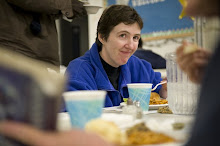Living into resurrection
I posted this as my Facebook status this morning:
Today is my Easter. Two years ago, I was diagnosed with cancer. I am healthy, and whole, and alive. I am grateful for everyone who walked with me through that time, and still. Every day is resurrection.
I remember that phone call—but now it feels like forever ago. So much has changed. I finished school, finished chemo, am out in the world now (rejoicing in the power of the Spirit!). I’m in a community now, which didn’t know me then. I’m beginning to do the work I was created to do.
What I learned then, is what I know now. The cure was medical. What truly healed me, what continues to heal me, is love.
I had to go to that horrible, fearful place—I had to be more afraid than I’d ever been, of a real mortal threat—to open myself up enough to the love around me, in my friends and in God. What I found, made it once and forever okay to be exactly the person I am.
I stood up in church today and said, I have two Easters. People understood. I got so many hugs afterwards—not out of pity for having been sick, but rejoicing in this cherished life. They know what cancer looks like; some who reached for me were survivors. And they see me here, healthy, alive, and claiming resurrection. Our deacon thanked me for bearing witness; she said that there are people here now who are going through it. No doubt. And I’m very aware of how lucky I am (I don’t say blessed, in this instance) that we caught it when we did.
I had two conversations today; one with a friend who is living through something far more horrifying than a cancer diagnosis, another who has gone through similar transformations but with a different cause. We bore witness to each other, the truth our lives have taught us: Love heals.
It sounds simple. And it is, but it isn’t. I keep talking about it, partly because I’m still processing all of this and learning how to carry the blessings of that time (love, freedom, knowing what’s important, healing), into this current life. And I know that I bear a responsibility to share the story I have lived. You can die and be resurrected. We are as strong, as faithful, as loving, as open, as we will need to be.
I remember the voice that spoke to me, two years minus a few days ago, while I was walking by myself through the Cal campus: “If you’re open to this, you can learn from it.” I clung to that for all I was worth. That is why I will tell you, cancer healed me.
Christ is in every one of us. Always. We have what we will need.
Alleluia, amen.
(Thank you to Cantus Mundi for the music.)





